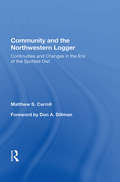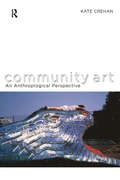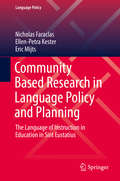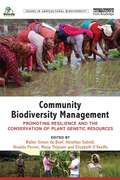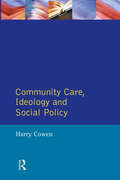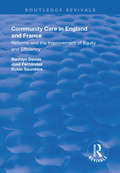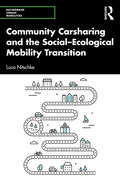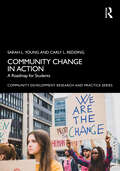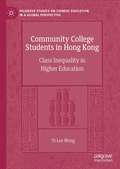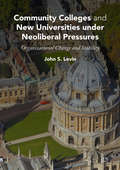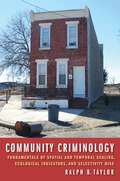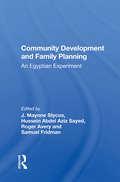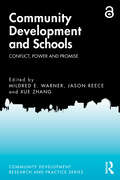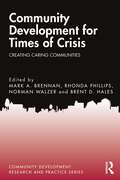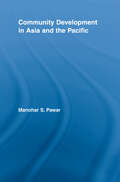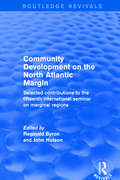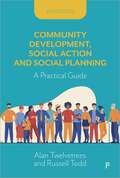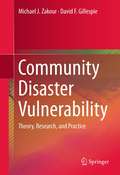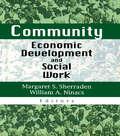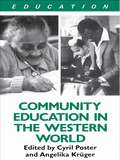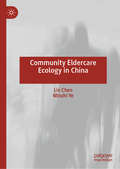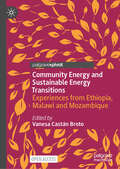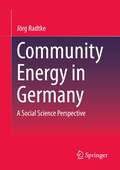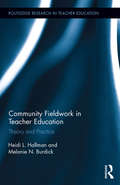- Table View
- List View
Community And The Northwestern Logger: Continuities And Changes In The Era Of The Spotted Owl
by Matthew S. CarrollIt has often been said that natural resource and environmental problems cannot be solved without solving human problems. In this book, Matthew Carroll examines the economic and social circumstances of northwestern U.S. loggers in the face of shifts in environmental politics, dramatic reductions in timber harvest levels on federal lands, and changing technology and market forces—among other factors that are rapidly transforming their industry, their livelihoods, and their communities. Drawing upon sociological fieldwork in logging communities that he conducted at various times over a period of nearly a decade and using the spotted owl-old growth controversy as a case study, Carroll provides a rich and detailed picture of life among northwestern loggers. He lays out the human dimensions and dilemmas of the timber crisis. Expanding it from the oversimplified owl-versus- logger confrontation, he puts these issues in a historical and policy context and suggests parallels to other controversies such as public grazing and federal or state river protection. Carrol’s work revives the concept of occupational community and shows ways it can be used to understand the dynamics of rural occupations linked to resource extraction.
Community Art: An Anthropological Perspective
by Kate CrehanExploring key issues for the anthropology of art and art theory, this fascinating text provides the first in-depth study of community art from an anthropological perspective.The book focuses on the forty year history of Free Form Arts Trust, an arts group that played a major part in the 1970s struggle to carve out a space for community arts in Britain. Turning their back on the world of gallery art, the fine-artist founders of Free Form were determined to use their visual expertise to connect, through collaborative art projects, with the working-class people excluded by the established art world. In seeking to give the residents of poor communities a greater role in shaping their built environment, the artists' aesthetic practice would be transformed.Community Art examines this process of aesthetic transformation and its rejection of the individualized practice of the gallery artist. The Free Form story calls into question common understandings of the categories of "art," "expertise," and "community," and makes this story relevant beyond late twentieth-century and early twenty-first-century Britain.
Community Based Research in Language Policy and Planning: The Language of Instruction in Education in Sint Eustatius (Language Policy #20)
by Nicholas Faraclas Ellen-Petra Kester Eric MijtsThis volume focuses on a case where community organizing, academic research and governmental responsibility were successfully mobilized and synchronized to bring about change in educational policy and practice. The focus of this book is the methodology implemented and the results obtained over the course of a year-long action research project on language and education in St. Eustatius, one of the islands of the Dutch Caribbean, commissioned by the educational authorities in both St. Eustatius and the European Netherlands. On the island, the language of instruction is Dutch, however, outside of the classroom most students only speak English and an English-lexifier Creole. The research project was set up to address the negative impact on school success of this disparity. It included a community-based sociolinguistic study that actively involved all of the stakeholders in the education system on the island. This was complemented by a multi-pronged set of research strategies, including a language attitude and use survey, a narrative proficiency test, in depth interviews, and a review of the relevant literature. The resulting report and recommendations were accepted by the government, which is now in the process of changing the language of instruction.
Community Biodiversity Management: Promoting resilience and the conservation of plant genetic resources (Issues in Agricultural Biodiversity)
by Walter Simon de Boef Abishkar Subedi Nivaldo Peroni Marja Thijssen Elizabeth O’KeeffeThe conservation and sustainable use of biodiversity are issues that have been high on the policy agenda since the first Earth Summit in Rio in 1992. As part of efforts to implement in situ conservation, a methodology referred to as community biodiversity management (CBM) has been developed by those engaged in this arena. CBM contributes to the empowerment of farming communities to manage their biological resources and make informed decisions on the conservation and use of agrobiodiversity. This book is the first to set out a clear overview of CBM as a methodology for meeting socio-environmental changes. CBM is shown to be a key strategy that promotes community resilience, and contributes to the conservation of plant genetic resources. The authors present the underlying concepts and theories of CBM as well as its methodology and practices, and introduce case studies primarily from Brazil, Ethiopia, France, India, and Nepal. Contributors include farmers, leaders of farmers’ organizations, professionals from conservation and development organizations, students and scientists. The book offers inspiration to all those involved in the conservation and use of agrobiodiversity within livelihood development and presents ideas for the implementation of farmers’ rights. The wide collection of experiences illustrates the efforts made by communities throughout the world to cope with change while using diversity and engaging in learning processes. It links these grassroots efforts with debates in policy arenas as a means to respond to the unpredictable changes, such as climate change, that communities face in sustaining their livelihoods.
Community Care Social Policy & Ideology
by Harry CowenThis book offers a comprehensive evaluation of community care strategies within the context of government social policy, and assesses the recent shifts of political power from Conservative to Labour towards the end of the century. Unlike the majority of texts in the field of community care, it makes explicit the historical, philosophical, social and political inter-connections, and therefore provides an in-depth understanding of changing policy issues for students, practicioners and managers in health and social care.
Community Care in England and France: Reforms and the Improvement of Equity and Efficiency (Routledge Revivals)
by Bleddyn Davies José FernándezFirst published in 1998, the aims of this book are: the comparison of community care service and financing systems, the comparison of reform arguments and history over the last decade, the comparison of who uses how much of what services, and with what impact on their needs and the probability of having to enter institutions for long-term care. The book breaks new ground by comparing systems from a new perspective and describing contemporary reform argument and proposals for the first time in the English language. It presents new evidence from the most ambitious collection and analysis of quantative data so far made for the comparison of the two countries (based on matched area samples collecting comparable information about cohorts of new users on two or more occasions). The book also shows how the need-related circumstances of users differ between countries and within each country between areas. The book shows how and why higher levels of the French cash benefit for community care had more effect on the central policy goal than its British counterpart, how higher levels of services generally had little impact on it in either country, but on average, how the effect of the British services were much greater.
Community Carsharing and the Social–Ecological Mobility Transition (Networked Urban Mobilities Series)
by Luca NitschkeThis book investigates how practices of community carsharing are influencing everyday mobility. It argues that hegemonic practices of automobility are reconfigured through practices of community carsharing, thereby challenging capitalist mobilities in the realm of everyday life. Through a detailed empirical study of practices of community carsharing and its practitioners in the rural regions around Munich, Germany, this book reveals how the practice contributes to the emergence of alternative automobile practices, meanings, identities and subjectivities. It also explores the embedding of automobility into its ecological context, the connection of function and community in practices of community carsharing and the changing of ownership relations through a process of commoning mobility. This reconfiguration of everyday practices of automobility takes place through processes of everyday resistance, re-embedding and commoning, and ultimately results in the emergence of an alternative mobility culture, thereby facilitating the dissemination of an alternative common sense of community carsharing. This book on community carsharing provides a valuable insight into carsharing in rural settings and exemplifies how carsharing specifically, and sharing mobilities in general, can contribute to a social–ecological mobility transition. The work will be of particular interest to scholars and practitioners working in mobility studies and mobilities.
Community Change in Action: A Roadmap for Students (Community Development Research and Practice Series)
by Sarah L. Young Carly L. ReddingCommunity Change in Action guides students through the process of turning their personal passion into goal-driven action for community development. Using an evidence-based curriculum, the book breaks down exactly how to initiate and drive social change in a way that speaks to the unique characteristics of Generation Z (Gen Z).Each chapter provides step-by-step actions, analyzes real-life examples, and supplies the necessary tools for success. The authors' multiple decades of experience leading students in community development, both in the United States and abroad, spawn a rich and engaging source for these examples. Each step is highlighted through Gen Z's narrated examples of using the guide and the associated toolkits to implement major social change initiatives, from Native American reservations to the slums of India and beyond.This book takes best practice approaches to youth leadership, community development, and social change beyond the classroom, inspiring and illustrating how Gen Z students can take their passion and turn it into social action.
Community College Students in Hong Kong: Class Inequality in Higher Education (Palgrave Studies on Chinese Education in a Global Perspective)
by Yi-Lee WongThis book presents a comprehensive account of the educational experiences of community college students in Hong Kong, analyzed through a theoretical lens that intersects sociological theories of inequality, including Bourdieu's concept of cultural capital. The student narratives featured in this book reveal the interweaving personal, academic, and professional considerations and challenges affecting their individual choices in the pursuit of higher education. Chapters also reveal why, despite the relative expansion of educational opportunities, the class gap in higher education persists.
Community Colleges and New Universities under Neoliberal Pressures: Organizational Change and Stability
by John S. LevinThis book examines seven higher education organizations, exploring their interconnected lines: organizational change and organizational stability. These lines are nested within historical, social, cultural, and political contexts of two nations--the US and Canada--two provinces and three states: Alberta, British Columbia, California, Hawai'i, and Washington. The author studies the development of the community college and the development of the university from community college origins, bringing to the forefront these seven individual stories. Addressing continuity and discontinuity and identity preservation and identity change, as well as individual organizations' responses to government policy, Levin analyzes and illuminates those policies with neoliberal assumptions and values.
Community Criminology: Fundamentals of Spatial and Temporal Scaling, Ecological Indicators, and Selectivity Bias (New Perspectives in Crime, Deviance, and Law #12)
by Ralph B. TaylorFor close to a century, the field of community criminology has examined the causes and consequences of community crime and delinquency rates. Nevertheless, there is still a lot we do not know about the dynamics behind these connections. In this book, Ralph Taylor argues that obstacles to deepening our understanding of community/crime links arise in part because most scholars have overlooked four fundamental concerns: how conceptual frames depend on the geographic units and/or temporal units used; how to establish the meaning of theoretically central ecological empirical indicators; and how to think about the causes and consequences of non-random selection dynamics. The volume organizes these four conceptual challenges using a common meta-analytic framework. The framework pinpoints critical features of and gaps in current theories about communities and crime, connects these concerns to current debates in both criminology and the philosophy of social science, and sketches the types of theory testing needed in the future if we are to grow our understanding of the causes and consequences of community crime rates. Taylor explains that a common meta-theoretical frame provides a grammar for thinking critically about current theories and simultaneously allows presenting these four topics and their connections in a unified manner. The volume provides an orientation to current and past scholarship in this area by describing three distinct but related community crime sequences involving delinquents, adult offenders, and victims. These sequences highlight community justice dynamics thereby raising questions about frequently used crime indicators in this area of research. A groundbreaking work melding past scholarly practices in criminology with the field’s current needs, Community Criminology is an essential work for criminologists.
Community Development And Family Planning: An Egyptian Experiment
by J. Mayone StycosProgram evaluation is not among the most popular of exercises, since it carries risks for all associated with it. Because every important program has friends and enemies anxious for its prosperity or demise, the investigators and their findings will normally be attacked from at least one side and not infrequently from both. But this is an occupational hazard, dutifully accepted by its practitioners; for some it even adds a zestful touch of danger. However, the program's sponsors and its participants require an unusual degree of courage, since negative or indifferent results are not infrequently used to impugn their wisdom or dedication. We applaud the courage of all those who, in the interest of improving policies and programs to further their clients' well-being, assumed the risks of introducing scientific program evaluation: Primary credit goes to the sponsor of the current research, the United Nations Fund for Population Activities (UNFPA), in particular the Mediterranean and Middle East Branch and its chief, Roushdi El Henedi. Special thanks go to Dr. Habib Siddiqui for his stimulus in launching the study. His efforts were followed by those of M.A. Abu-Nuwar, whose bureaucratic and diplomatic skills were much appreciated, and Sylvia Rhodes, who was of assistance near the close of the project. UNFPA staff in Egypt, in particular Hamed Fahmy, were most helpful in the field. Needless to say, neither these individuals nor the UNFPA necessarily agree with the conclusions reached in this book.
Community Development and Schools: Conflict, Power and Promise (ISSN)
by Mildred E. Warner Xue Zhang Jason ReeceThis book lays out the promise and potential of schools as community-building institutions. It explores the challenges faced in incorporating schools into broader community development policy, and also recognizes the changing demographics of schools and their need to integrate with economic development policy in order to promote broader community development.The book includes chapters on tax abatements and economic development policy impacts on schools, new approaches to school building renovation, the potential and reach of shared services between communities and schools, and the impact of school-based health centers. It also offers a theory to integrate schools into community development. Key elements include shared power between communities and schools, greater transparency in economic development policy, collaboration across the broad range of community actors, and engagement of diverse voices. These elements build a greater sense of belonging across generations and class and racial divides.Creative democracy can broaden both school and community development agendas and build a culture of health. This book will help community development and school leaders recognize and pursue the promise of schools as critical community development actors.The Open Access version of this book, available at http://www.taylorfrancis.com, has been made available under a Creative Commons Attribution-Non Commercial (CC-BY-NC) 4.0 license.
Community Development for Times of Crisis: Creating Caring Communities (Community Development Research and Practice Series)
by Mark A. BrennanThis book explores the intersection of community development and local capacity building as a basis for effective disaster mitigation and the alleviation of suffering in times of crisis. Beginning with the Community Development section, the process, context, and methods for community, engagement, and development can be viewed from different structural and logical approaches. This section explores some of the more relevant historical arguments, as well as more contemporary examinations. The second section looks at Critical Human and Community Considerations and sheds light on some of the key concepts that are often overlooked (poverty, race, inequality, social justice, mental health, social division) when framing community responses to disaster. The third section focuses on Fundamental Elements of Caring Communities. This section explores the importance, practical, and measurable impacts of social support, empathy, inclusion, and conflict resolution in creating effective and caring community responses. Finally, the last section focuses on practice and brings together research and theory into applied programming, examples, and evidence from on-the-ground efforts to establish caring communities that respond to local needs in times of crisis and beyond. By addressing these objectives, this book provides a more complete understanding of the essential role that community can play in disaster mitigation. Doing this will provide a better focus for ongoing research endeavors, and program and policy initiatives at the community level that seek to prepare for, respond to, and recover from natural and other disasters. As a result, this book contributes to wider and more sustainable development of our communities beyond disasters, while furthering dialog among community scholars and practitioners.
Community Development in Asia and the Pacific (Routledge Studies in Development and Society)
by Manohar S. PawarThere is a tremendous need for community development practice in the Asia-Pacific region due to its size and prevailing diverse socio-economic, political and cultural needs and issues. Both developed and developing countries have been reemphasizing the importance of community development and have introduced several schemes or programs for overall development. Manohar Pawar familiarizes readers with the region, presents the major social, economic and political issues, looks at values and principles, and critically analyses challenges and shows opportunities for community development practice in the region. This book will allow for anyone interested in community development both at local and global levels – scholars, non-government organizations (NGOs), government organisations, international aid agencies – to gain a broad understating of community development trends in the Asia-Pacific region.
Community Development in an Uncertain World
by Jim IfeCommunity Development in an Uncertain World provides a comprehensive and lively introduction to modern community development. The book explores the interrelated frameworks of social justice, ecological responsibility and post-Enlightenment thinking, drawing on various sources including the wisdom of Indigenous peoples. Recognising the increasing complexity and uncertainty of the times in which we live, Jim Ife promotes a holistic approach to community development and emphasises the different dimensions of human community: social, economic, political, cultural, environmental, spiritual, personal and survival. The first section of the book examines the major theories and concepts that underpin community development. This includes a discussion of core principles: change and wisdom 'from below', the importance of process and valuing diversity. The second section focuses on practical elements, such as community work roles and essential skills. The final chapters discuss the problematic context of much contemporary practice and offer vision and hope for the future.
Community Development on the North Atlantic Margin: Selected Contributions to the Fifteenth International Seminar on Marginal Regions (Routledge Revivals)
by John Hutson Reginald ByronThis title was first published in 2001. Isolated communities, dependent upon fishing, farming and forestry, which are scattered around the North Atlantic coast, have shared a disastrous decline during the last decade. These communities are in the peripheries of advanced industrial nation-states, such as Canada and supra-national alliances, such as the European Community, yet despite this, there are no easy solutions to the development of these regions. This volume argues that the productive assets of these regions, and how they can be used to sustain household incomes, need to be better understood. The assets need to be converted into products and services and they need to be marketed profitably. The diminshing flow of young people who leave these areas to obtain higher education and who do not return must be turned around and efforts must be concentrated on the creation or strengthening of economic conditions which satisfy the younger generation's employment aspirations, consumer requirements and social needs.
Community Development, Social Action and Social Planning 6e: A Practical Guide
by Alan Twelvetrees Russell ToddThe sixth, fully updated edition of this bestselling guide links the theory and practice of community work in an insightful and relatable read for students and practitioners alike. With an accessible style, experienced author Alan Twelvetrees sets out the realities of practice in everyday community development (CD) work. With a much-expanded section on specialist community work, the guide also features brand new sections on work in health, housing, with children, young people and those with disabilities and the changing role of IT, particularly since the COVID-19 pandemic. This edition features: • clear ‘how to’ guides for a variety of CD-related practice; • case studies; • end of chapter discussion points; • signposts to digital resources; • glossary. This classic text provides a comprehensive overview of the knowledge required to work in community practice in the UK and is essential for anyone studying or working in the field.
Community Disaster Vulnerability: Theory, Research, and Practice
by David F. Gillespie Michael J. ZakourDisaster vulnerability is rapidly increasing on a global scale, particularly for those populations which are the historical clients of the social work profession. These populations include the very young and very old, the poor, ethnic and racial minorities, and those with physical or mental disabilities. Social workers are increasingly providing services in disasters during response and recovery periods, and are using community interventions to reduce disaster vulnerability. There is a need for a cogent theory of vulnerability and research that addresses improved community disaster practice and community resilience. Community Disaster Vulnerability and Resilience provides a unifying theoretical framework backed by research which can be translated into knowledge for effective practice in disasters.
Community Economic Development and Social Work
by Margaret S SherradenIn Community Economic Development and Social Work, you’ll find innovative theoretical approaches to the newly emerging field of community economic development (CED). You’ll see how community leaders, residents, community organizations, social workers, city planners, local business owners, bankers, and/or investors can come together to promote successful CED.Community economic development (CED) is a strategy that addresses social and economic development goals, creates jobs, builds assets, and strengthens the social fabric of communities. In Community Economic Development and Social Work, you&’ll learn how to promote community-based organizations that involve residents in articulating goals, policies, and operations and moves them beyond poverty. You’ll also gain valuable insight into: methods of evaluating a variety of CED initiatives in different geographical areas microenterprise development and the experiences of low-income entrepreneurs, including examples from Bangladesh and India and in immigrant and low-income communities in the United States home ownership as a key CED strategy in low-income neighborhoods environmental issues and sustainable CED healthcare and CED--entrepreneurial opportunities and job creation organizations, such as Community Development Corporations, that promote CED practicing CED in marginalized communities strategies for creating jobs, developing structures for savings and investment, creating access to credit, promoting land trusts, financing community infrastructure improvements, providing training and technical assistance, and developing social services Contributors to this groundbreaking volume include internationally known scholars and practitioners who examine community economic development initiatives from a variety of perspectives and locales--CED is one of the few areas of applied social science where diffusion regularly occurs from “less developed” to “developed” countries. The variety of models and case studies in Community Economic Development and Social Work gives you practical ideas for effective economic development--development that empowers residents to break the cycle of poverty and offers hope and opportunity for the future--in low-income and minority communities.
Community Education and the Western World
by Angelika Krüger Cyril PosterFirst published in 1990. Routledge is an imprint of Taylor & Francis, an informa company.
Community Eldercare Ecology in China
by Lin Chen Minzhi YeInformed by the social-ecological framework, this book focuses on the development of Home and Community Based Services (HCBS) in urban China. Bringing a timely discussion around HCBS development in Shanghai, it presents an interplay of formal caregiving relationships, evolving caregiving culture, and the trajectory of long-term care in China. Drawing on surveys, in-depth interviews, and government archives, this book explores the emergence of one of the most developed HCBS programs in Shanghai, its development over the past decade, its administration and services, resource allocation, staff members’ work experiences, older adults’ service experiences, as well as service evaluation and improvements. Offering fresh insight into new forms of caregiving in community settings, and shaping a new discourse on caregiving policy, this book is a key read for both students and practitioners in the fields of long-term care, gerontology, geriatrics, health care, and health policy.
Community Energy and Sustainable Energy Transitions: Experiences from Ethiopia, Malawi and Mozambique
by Vanesa Castán BrotoThis open access book engages with the difficulties of delivering community energy in practice, building on practical experiences in Ethiopia, Malawi, and Mozambique. In these countries, where many people lack access to electricity, community energy is an alternative to advance universal energy access. This book argues that, besides providing access, community energy is essential for achieving justice and resilience in sustainable energy transitions. Community energy combines off-grid infrastructures with innovative forms of governance to incorporate the perspectives of beneficiaries in the generation and distribution of electricity. Community energy has multiple benefits for communities, such as facilitating the adoption of renewable technologies, providing energy access where it is lacking, and building resilience. They also offer societal benefits beyond beneficiary communities, such as providing additional capacity to existing grids, delivering off-grid services where the grid is absent, and bridging on-grid and off-grid systems. Despite its promises, however, the adoption of community energy has been slow. This book presents a feminist-informed perspective on community energy to advance energy justice that puts disadvantaged communities at the centre of sustainable energy transitions. It also explores the room for manoeuvre within existing regulatory systems, supply chains, and delivery systems to facilitate its development. By engaging with existing experiences in community energy, the book demonstrates the potential of communities to gain control over their energy needs and resources and argues for the need to develop a wide range of transdisciplinary skills among policymakers, technicians and communities to deliver a just energy transition.
Community Energy in Germany: A Social Science Perspective
by Jörg RadtkeIn this ground-breaking book, Jörg Radtke offers for the first time within research, a comprehensive insight into the range of organizational structures of community energy projects in Germany and their contribution to the Energiewende. Based on nationwide quantitative survey data and in-depth analyses of selected case studies of solar, wind and geothermal projects, Radtke documents the social structure and motivations of participating citizens. He examines new forms of material participation, community building and co-determination within the mostly volunteer-led community energy projects based on the civic engagement patterns of active “green citizens”. The author identifies a new form of individualistic participation and collective modes of action in line with new types of project-oriented participation between business, politics and civil society within sustainability transformation processes of the early 21st century.
Community Fieldwork in Teacher Education: Theory and Practice (Routledge Research in Teacher Education)
by Heidi L Hallman Melanie BurdickIn teacher education, field work in community-based spaces (including foster homes and programs for homeless youth) is frequently contrasted with "traditional" field experiences in classroom settings, where beginning teachers are immediately introduced to teacher-centered models of instruction. This volume works against such a model, presenting a counter-narrative of new teachers’ understanding of the act of teaching. By exploring their work with at risk youth in community-based sites, the authors uncover how non-traditional spaces for teaching and learning have the potential to open new doors for reimagining the teaching act and teacher identity. This volume examines how prospective teachers have used writing within unconventional spaces as catalysts for considering what it means to become a teacher, as well as how the work of teaching can be conceptualized. It unites the practical aspects of field work and with theoretical conceptions of teaching, and envisions how the work and the definition of "teaching" can be broadened.
